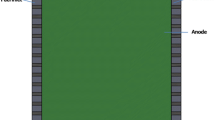Abstract
In this study the influence of a thin hydrodynamic boundary layer on the heat transfer from a single circular cylinder in liquid metals having low Prandtl number (0.004–0.03) is investigated under isothermal and isoflux boundary conditions. Two separate analytical heat transfer models, viscous and inviscid, are developed to clarify the discrepancy between previous results. For both models, integral approach of the boundary layer analysis is employed to derive closed form expressions for the calculation of the average heat transfer coefficients. For an inviscid model, the energy equation is solved using potential flow velocity only whereas for a viscous model, a fourth-order velocity profile is used in the hydrodynamic boundary layer and potential flow velocity is used outside the boundary layer. The third-order temperature profile is used inside the thermal boundary layer for both models. It is shown that the inviscid model gives higher heat transfer coefficients whereas viscous flow model gives heat transfer results in a fairly good agreement with the previous experimental/numerical results.




Similar content being viewed by others
Abbreviations
- c p :
-
specific heat of fluid [J/kg·K]
- D :
-
diameter of circular cylinder [m]
- h :
-
average heat transfer coefficient [W/m2·K]
- k :
-
thermal conductivity [W/m·K]
- Nu D :
-
Nusselt number based on diameter ≡ Dh/k f
- Pe D :
-
Peclet number based on diameter ≡ Re D Pr
- q :
-
heat flux [W/m2]
- Re D :
-
Reynolds number based on diameter ≡ D U app/ν
- s :
-
distance along curved surface of cylinder measured from forward stagnation point [m]
- T :
-
temperature [°C]
- U app :
-
approach velocity [m/s]
- U(s):
-
velocity in inviscid region just outside boundary layer [m/s]
- UWF:
-
uniform wall flux
- UWT:
-
uniform wall temperature
- u :
-
s - component of velocity in boundary layer [m/s]
- v :
-
η - component of velocity in boundary layer [m/s]
- x, y :
-
Cartesian coordinates
- α:
-
thermal diffusivity [m2/s]
- Δ:
-
thermal boundary-layer thickness [m]
- δ:
-
hydrodynamic boundary-layer thickness [m]
- δT :
-
thermal boundary layer thickness [m]
- η:
-
distance normal to and measured from surface of elliptical cylinder [m]
- λ:
-
pressure gradient parameter
- ν:
-
kinematic viscosity of fluid [m2/s]
- ρ:
-
fluid density [kg/m3]
- θ:
-
angle measured from stagnation point [radians]
- ζ:
-
ratio of hydrodynamic to thermal boundary layer thickness ≡ δ/δT
- a:
-
ambient
- f:
-
fluid
- H:
-
hydrodynamic
- s:
-
separation
- T:
-
thermal
- w:
-
wall
References
Grosh RJ, Cess RD (1958) Heat transfer to fluids with low prandtl numbers for flow across plates and cylinders of various cross sections. ASME Trans 80(3):667–676
Cess RD, Grosh RJ (1958) Heat transmission to fluids with low prandtl numbers for flow through tube banks. ASME Trans 80(3):677–682
Andreevskii AA (1959) Heat transfer in transverse flow of molten sodium around a single cylinder. Sov J At Energy 7:745–747
Ishiguro R, Kumada T, Sugiyama K, Ikezaki E (1976) Experimental study of heat transfer around a circular cylinder in a liquid sodium cross flow. Int Chem Eng 16(2):249–253
Sugiyama K, Ishiguro R (1978) Numerical study of local heat transfer around a circular cylinder in a liquid sodium cross flow. Heat Transf Jpn Res 7(4):59–68
Ishiguro R, Sugiyama K, Kumada T (1979) Heat transfer across a circular cylinder in a liquid sodium cross flow. Int J Heat Mass Transf 22(7):1041–1048
Khan WA (2004) Modeling of fluid flow and heat transfer for optimization of pin-fin heat sinks. PhD Thesis, Department of Mechanical Engineering, University of Waterloo
Pohlhausen K (1921) Zur Näherungsweise Integration der Differential Gleichung der Laminaren Reibungschicht. Zeitschrift für angewandte Mathematic und Mechanic 1:252–268
Schlichting H (1979) Boundary layer theory, 7th edn. McGraw-Hill, New York
Van der Hegge Zijnen BG (1956) Modified correlation formulae for heat transfer by natural and forced convection from horizontal cylinders. Appl Sci Res A 6(2–3):129–140
Acknowledgments
The authors gratefully acknowledge the financial support of Natural Sciences and Engineering Research Council of Canada and the Center for Microelectronics Assembly and Packaging.
Author information
Authors and Affiliations
Corresponding author
Rights and permissions
About this article
Cite this article
Khan, W.A., Culham, J.R. & Yovanovich, M.M. Analytical study of heat transfer from circular cylinder in liquid metals. Heat Mass Transfer 42, 1017–1023 (2006). https://doi.org/10.1007/s00231-005-0068-4
Received:
Accepted:
Published:
Issue Date:
DOI: https://doi.org/10.1007/s00231-005-0068-4




